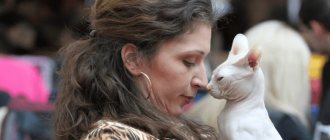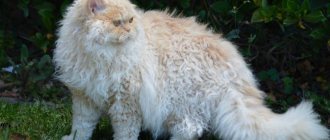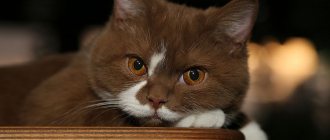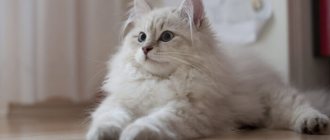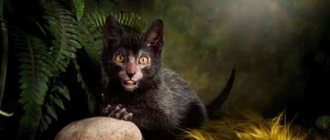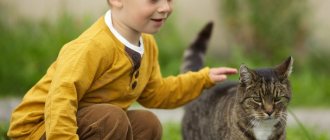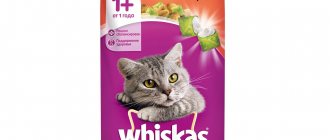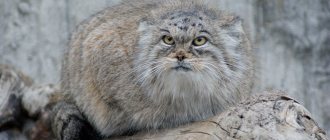The history of short-legged cats
The reason for the short legs is not due to the selection work of felinologists, but to an accidental genetic failure. Cats with short legs are born with the gene for achondroplasia (a combination of dwarfism with disproportionate development of the limbs). The important thing is that achondroplasia does not spread to the entire body, but only affects the formation of the limbs. The remaining bones and spine remain unaffected by the spontaneous genetic mutation. “Short Paws” are not prone to arthritis and have no problems with movement.
Short-legged cat
The official history of the appearance of short-legged cats began in 1983 in Louisiana, where music teacher Sandra Hochenedel saved a pregnant cat with disproportionately short limbs from a bulldog and named her Blackberry (Blackberry). In due time, Blackberry gave birth to offspring, which included a short-legged kitten. Sandra named it Toulouse and gave it to her farmer friend. Soon, many short-legged cats appeared in the area around the farm, looking like a cross between a dachshund and a ferret. The “short-legged dog” was identified as a separate breed and called the Munchkin.
Official recognition of the breed took place in 1991. Short-legged cats appeared in Russia at the beginning of the 21st century.
History of the origin of the breed
Short-toed cats were talked about in England back in 1930, where 4 generations of such cats were born. But, unfortunately, the Second World War affected their numbers, and Munchkin cats practically disappeared from human sight.
The modern history of munchkins began in 1983. Sandra Hochenedel, an American from Louisiana, once picked up a black and white pregnant cat with short legs. She named her new pet Blackberry. Blackberry settled under an old abandoned campervan and, out of habit, led a semi-wild lifestyle. The girl assumed that the shortened legs were a consequence of the cat's illness and difficult childhood. Otherwise, she was quite healthy and active, and her reproductive functions were clearly all right.
Blackberry had offspring, and Sandra was surprised when, among the others, she saw kittens with short legs. She gave one such kitten named Toluus to a friend, farmer Kai LaFrance. The kitten grew up and within a year a short-legged offspring appeared from him and an ordinary cat, and some time later numerous dachshund cats settled within the ranch. Today we can safely say that all modern munchkins descended from Blackberry and Toluus.
The Munchkin cat breed was officially registered in the United States in 1985. Very soon it gained popularity in European countries, and cats of this breed reached Russia only at the beginning of the 21st century. An interesting fact is that the breed got its name from the short magical people who are described in the book “The Wizard of Oz.” They were called munchkins in the book.
Munchkins are already officially registered by many felinological organizations, including WCF and TICA.
Taking into account the experience of American, South African and Japanese clubs, we can predict a surge in the popularity of munchkins. Exotic appearance, compact size and bright temperament bring the breed more and more fans. On the Russian-speaking Internet, the impending epidemic has been dubbed “munchkinomania.”
Video review of the Munchkin cat breed:
Characteristics of short-legged cats
What are the benefits of cats with short legs? The owners of such pets claim that they have an amazing character. They are intelligent, sociable, good-natured, inquisitive and cheerful, that is, they are suitable as a companion for any person, even with the most gloomy character. These cats are affectionate and playful, so they will return a good mood to any owner.
At the same time, they are self-sufficient and intelligent, so they will not “bother” you when you don’t want it. Such pets easily get along with other cats or other pets. They are not at all embarrassed by their short legs, but they can always stand up for themselves, since they are naturally endowed with a strong spirit.
Munchkin
Do you like little cats? Then you must have a favorite, and most likely it is a munchkin. The breed is the parent of most short-legged cats.
Munchkin is a breed of short-legged cats
These are representatives of the cat family with an elongated body and short legs. This breed was not bred artificially. It appeared as a result of a natural mutation. Males on average can reach a weight of up to 4 kg, females - a little less. These pets love to sit on their hind legs.
When it comes to caring for these amazing cats, special attention should be paid to nutrition. Cats of this breed are often overweight, so owners need to eliminate any possibility of uncontrolled feeding of their pet.
Short-haired representatives of the breed require less grooming than long-haired ones. For individuals with short hair, it is enough to brush them once a week, and for those with long hair, twice a week. This procedure will get rid of lost hair and prevent tangling of the fur.
Another important point is timely cleaning of the ears and trimming of the nails. Veterinarians recommend brushing your cat's teeth once a week. The sooner you accustom your kitten to these manipulations, the easier it will be to care for him in the future.
A kitten of this breed will cost you a considerable amount. The minimum price for a healthy pet will be about 55 thousand rubles. There are few nurseries specializing in this breed. Therefore, you will have to pay extra for the rarity of the pet.
Description of the Munchkin breed
The way the Munchkin breed looks always evokes the same range of feelings in those who meet them for the first time. At first it is surprise, then pity, and after that there is certainly admiration and joy. After all, short-legged munchkin cats are a smile in its purest form! The smile is black, white, gray, red - depending on the color of the cat. The breed standard has not yet been finalized, but the main, basic criteria have already been included in the description.
- The head is wide, with smooth contours, and the silhouette resembles a wedge. The head size is average; in general, the body and head sizes are proportional. Adult cats have more developed heads than female cats:
the nose is average, a slight deflection is not a drawback; The ears are set high and wide. They are well and noticeably pubescent, wide at the base, rounded at the tips; the eyes are shaped like a walnut. For a big walnut! Placed wide, at a slight angle to the ears
IMPORTANT! Eye color does not depend on color, the main thing is that the eyes are rich and even in color; The neck is thick, muscular, and of medium length.
- The body, according to breed standards, is Semi-foreign type. That is, the sizes and proportions are quite average (with one exception, of course). The hind legs are slightly longer than the front legs, and therefore there is an increase in proportions from the withers to the croup. The frame is not heavy, but not lightweight either. But the muscles of munchkins are well developed and this point is noted in all reviews about the breed. The length of the body corresponds to the length of the tail. When moving, both the Munchkin kitten and the adults hold it vertically.
Paws are the four main differences between munchkins and other cat breeds. They are short. But straight! However, a slight curvature of the front paws towards the inside is allowed. The hind legs, as noted, are longer than the front legs.
The weight of short-legged cats reaches 3-4 kg, females - 2-3.6 kg
- The coat, according to standards, can be either short (SH) or long (LH). In the first case, the fur is shiny and plush in tactile sensation. Evenly colored "kangaroo" munchkins may have heavier coats. In the second case, the wool has remarkable protective properties, it is dense and silky, and the collar is lordly.
- Color. The description of colors can begin now and never end. After all, any color scheme is allowed. Moreover, it has been noticed that the same color looks different on short-haired and long-haired “kangaroos”.
Bambino
You can buy a kitten of this breed at a nursery; most likely, they will give you a young Canadian Sphynx. When purchasing, pay attention to the cleanliness of the animal's eyes and ears, as well as its character. The kitten should not be afraid of you. The price for a representative of this breed can vary from 70 to 350 thousand rubles.
Banbino is a breed of hairless, short-legged cats.
This is a hairless cat breed with short legs that was developed by crossing Munchkins with Sphynx cats in the United States. The name of the breed literally translates from Italian as “child”. The average weight of such a cat is about 3 kg. They also have an endearing habit of sitting on their hind legs.
As for care, he does not need special care. The cat has good physical characteristics, loves to frolic, and is able to remember and perform simple tricks. In other words, kittens of this breed have excellent health. True, they often freeze due to the lack of fur, so try to keep the air temperature at home from falling below 22 degrees. By the way, you can try a blouse on your cat if you decide to take her for a walk. Most likely, she will not refuse.
Separation from the owner negatively affects the bambino: the animals even refuse to eat. This factor must be taken into account when deciding to get a pet. Cats tolerate moving, travel, and new surroundings well and quickly adapt to new conditions.
Description of the Munchkin breed
Apart from shortened limbs, munchkins are visually no different from ordinary cats, with short or long hair. The outcross program, according to which the breed is developing, provides for genetic diversity; for this purpose, as well as to obtain the necessary characteristics in the offspring, other breeds are used, in addition to ordinary domestic animals. At the same time, the task of breeders is to ensure that the result of selection does not resemble a miniature copy of a purebred pet.
Standard
The Munchkin breed standard is established by the International Cat Association (TICA). In addition to the characteristic shortened legs and slightly rounded chest, the exterior meets the following criteria:
- Head: relatively wide, a modified wedge with slightly rounded contours. The cheekbones are high, the muzzle is moderate with a firm chin, a flat forehead and a nose of medium length, which is permissible for a slight deflection.
- Ears: Triangular, relatively large, set vertically, wider at the base with rounded tips.
- Eyes: Large, walnut-shaped, set wide and at a moderate angle to the base of the ears. The cat's color does not affect their color, but it should be clean and expressive.
- Body: medium length, with pronounced muscles, strong thighs. Due to the more elongated hind limbs, there is a smooth rise of the body from the withers to the croup of the animal. The tail is of medium thickness, tapers to a rounded tip, and is carried vertically when moving.
- Limbs: short, hind legs slightly larger than forelimbs. The forelimbs are approximately 7.5 cm in length. The four paws are set straight, without curving in or out.
- The average lifespan of a Munchkin is 14-16 years, which is similar to the typical age of other cat breeds.
- The standard weight of adult cats is between 2 and 4 kg.
- The breed allows both short and long thick and soft wool, with developed undercoat, without restrictions regarding color.
Health
When the registration of the new breed was considered, some experts were against it because they believed that cats were genetically inferior and would have the same health problems as dogs with short legs, such as dachshunds. However, research shows that the Munchkin breed is characterized by good health and does not have many specific diseases.
Only occasionally are pets diagnosed with lordosis. The disease consists of a curvature of the spine that bends into the body due to shortening of the muscles that support it in the correct position. This puts pressure on the trachea, lungs and heart. Lordosis is a relatively rare disease and cats of other breeds are prone to it. In addition, Munchkins are predisposed to pectus excavatum.
Character
These unusual short-legged cats are distinguished by their cheerful disposition and friendliness, which makes them ideal companions. Munchkins are social by nature and get along well with children and pets who live in the house. They need constant communication, which means they cannot be left alone for a long time.
Cats are easy to train, so it’s easy to teach your pets tricks from early childhood. Short legs are not a deterrent for climbing curtains, bookcases or sofas. They are amazingly fast and flexible when needed.
Munchkins are observant
You can often see a cat standing on its hind legs, trying to see what has attracted its attention. They are even called “kangaroo cats” for this manner.
Napoleon (minuet)
Napoleon is the result of crossing a Munchkin with a Persian. In 2005, the International Cat Association recognized the new breed. At first the cat was named in honor of the great commander Napoleon Bonaparte, but in 2015 the breed was given another name - Minuet.
Napoleon (minuet) - a breed of long-haired, short-legged cats
The cat has a round muzzle and large eyes, the muzzle is more like the muzzle of a fluffy Persian. The wool is very thick, its length and color can vary. Weight no more than 2 kg. Jumping and falling from heights are especially dangerous for Napoleons.
Napoleons are very gentle and affectionate pets, ready to stay with their owner all day long. Their sociability and friendliness have no boundaries. Cats are extremely attached to one owner, but treat all family members with respect. These cats absolutely do not know how to show aggression, so the breed is ideal for families with small children.
Napoleon kittens are loved for their extremely kind nature. They quickly get along with small children and will never scratch a child. Of course, this feature also has a drawback - if you are walking with a kitten on the street, carefully monitor it. There is a risk that he will fall into the hands of strangers.
Cats with short legs of this breed are very unpretentious in care. Of course, the most important thing is to take time to care for the fur of the purr - it must be combed regularly. If the kitten has too long hair, repeat the procedure 2-3 times a week. If you have adopted a short-haired pet, it is enough to brush it once a week.
The price of a kitten depends on the pedigree, color and length of the paws, ranging from 30,000 to 80,000 rubles.
Breeds of dwarf cats
Munchkin
Dwarf munchkin cats are very similar to dachshunds - short legs, a long body and a vertical tail (they are often called dachshund cats). They sit not on their hind legs, but on their seat, while resting their tail.
Their color can be different, eye color - from greenish to sky blue. White individuals have eyes of different colors. There are short-haired plush and long-haired munchkins with silky fur.
Munchkins appeared as a result of natural mutation. This feature shortened their legs by more than 2-3 times, without affecting the spine.
By nature, cats are very affectionate and calm, they love to play with children and just lie on their owner’s lap. Despite their short legs, these miniature cats love to explore new things and handle any kind of travel well.
The name is given in honor of the tiny creatures "munchkins" from the book "The Wizard of Oz".
INTERESTING: It is the Lilliputian munchkin from California that is recognized as the smallest cat in the world - he is only 13.33 cm in length.
Munchkins became the descendants of many dwarf cats.
Napoleon
The result of crossing munchkins with Persian cats, weighing from 2.3 to 4 kg. Their round, slightly flattened muzzle and wide-set eyes make them very similar to ordinary Persians. Napoleon can be any color, just like his eye color.
Their disposition is calm and peaceful, they even treat strangers well (which can be dangerous).
Napoleon dwarf cats are a fairly expensive breed due to the difficulty of breeding them. The price of dwarf Napoleons ranges from 50 thousand rubles.
Bambino
Mix of munchkins with the Canadian hairless sphinx, weighing up to 4 kg. Bambino - from the Italian word for "child", was named by the Osborne couple for its tiny size.
Their appearance is specific - large, wide-open ears, a rounded muzzle, bright blue or green eyes and an elongated body without hair.
By nature, they are very good-natured, love to play with children and do not show signs of aggression. They have well-developed muscles and are very mobile.
IMPORTANT: Bambinos have one weakness - they are very susceptible to cold and heat, therefore, they should be protected from sudden temperature changes. In addition, cats are afraid of water, and they need to be bathed often.
Being a rare and not yet widespread breed, bambinos are one of the most expensive breeds. It is often possible to buy a mini bambino cat only abroad, carefully checking the information from the sellers. There are often cases when buyers are deceived by providing cats of the wrong breed.
Minskin
Dwarf hairless cats obtained by crossing Munchkins with the Canadian Sphynx, weighing 1.8-2.7 kg. Their appearance resembles slightly shaggy sphinxes; their fur can be in patches on the face, along the entire length of the paws, tail and ears. The ears are pricked up, slightly rounded, the head is round, the eyes are set wide.
Mini cats of the Minskin breed are unpretentious, adapt well to any conditions and get along well with other animals. They are very affectionate and playful, patient enough to play with children and at the same time very active.
IMPORTANT: Their weak side is the fear of sunburn and severe frosts, which can easily be avoided by wearing them in winter and protecting them from the sun.
Lambkin
A cute and fluffy kitten with curly fur is the result of crossing a Munchkin with a Selkirk Rex. From rexes they have large pointed ears and luxuriant hair, from munchkins they have short legs and height. Their coloring is usually light, with dark paws. Miniature lambkins are great friends for a loving owner - they are very affectionate and love to play.
The name comes from the English word “lamb” (due to its curly fur), which needs to be brushed at least once a week.
Skookum
American Roy Galusha tried for a long time to breed a small cat with fluffy fur, and he managed to do it by crossing the same munchkins with La Perm. They look exactly like their ancestors: short legs, small body and curly hair.
In translation, skukum means “brave, unbending,” which completely defines the character of these furry babies - they are very curious and active. They are also affectionate, sociable and quite quiet.
IMPORTANT: The only condition for keeping them is that they need to be bathed and brushed at least once a week, which gives them pleasure.
Dwelf
Perhaps one of the most amazing species was obtained by crossing a Munchkin, a Canadian Sphynx and an American Curl. Their appearance is quite specific - a hairless body, short legs, large curled ears and piercing eyes.
Their weight ranges from 1.8-3 kg. The color can be completely different - from gray to lilac shades.
Dwelfs are very calm and sensitive; if you inadvertently offend them, they can hide from you for a long time.
They got their name because of their resemblance to mythical elves.
IMPORTANT: To this day, the breed is considered experimental (brought out in 2007), and is not recognized by international organizations. They can only be purchased in North America at a very expensive price.
Kinkaloe
A small breed cat with adorable curled curl ears. Munchkins gave them short legs and a small body. Weight in females ranges from 1.3 to 2.kg, in males 2.2-3.1 kg. Outwardly, they are similar to Napoleons, with the exception of ears and a long tail. They have long, soft fur that needs to be brushed.
Kinkalows have a calm temperament, they are sociable and playful. Their mischievous disposition does not allow them to sit still; they are always on the move.
Bengal cats
They come in different sizes (including dwarf ones), depending on the area of residence. Unusual dwarf “leopards” can quickly go wild without an owner.
Genet
Crossing Bengal cats with Munchkins and Savannah cats resulted in dwarf kittens that look exactly like their wild ancestors. Familiar predatory eyes, silky fur and leopard print.
Despite their origin, genets are very affectionate and friendly, they love to play and explore new things.
Devon Rex
Devon Rex has Small short-haired cats with large pointy ears and a piercing look as if surprised eyes, were first met in England. Their ears are large, slightly rounded, their fur is wavy and even. The colors can be absolutely any, just like the eye color.
Like true Britons, Devons are calm, quiet, very affectionate and curious. They are often called a poodle cat, which is complemented by the fact that they are ready to run after a stick over and over again, bring you toys, etc.
Balinese (Balinese cat)
Tiny cats descended from Siamese cats, which they resemble. They have fairly long fur and a long fluffy tail.
The character of cute Balinese dogs is quite calm, they love to play, and, at the same time, they love peace and quiet. They never show signs of aggression unless they are defending something that is dear to them.
The peculiarity of dwarf Siamese cats is that they are born completely white, and later acquire a characteristic color.
Singapore
Cute cats weighing up to 2.5-3 kg, which appeared in Singapore, where they are a “living national monument” of the country.
They have small, slightly rounded ears, a long tail and a short-haired body of a beige-coffee color.
Singapura cats have a peaceful disposition, they are very sociable, they love to play with children and cuddle on their owner’s lap.
Skif-tay-don
The smallest cat breed is the Scythian Tay-Don, weighing from 0.9 to 2.5 kg. They appeared in Rostov-on-Don, where breeder Elena picked up a cat with four creases on its tail. Mishka (that’s what the cat was called), a few years later, fathered offspring with a Thai woman, Sima, whose tail was a donut.
One of their kittens, very small, with a short tail, became the first cat of the Scythian-Tai-Toy-Don breed. Among other things, miniature cats are characterized by Siamese coloring; much less often they are mink, chocolate or painted.
These little ones have a very pleasant character, they love to play and explore new spaces, become very attached to their owner, get along well with other animals, but will not allow themselves to be offended.
The name is given after the land of the Scythians, its external similarity with Thai cats, the river on which the city is located and its toy (toy). The generally accepted international name for the breed is toybob (toy bobtail).
This breed is bred in Moscow and Yekaterinburg, where you can buy miniature cats.
Lamkin
The breed is distinguished by curly hair and weight, from 1800 to 4000 grams. Representatives of this breed are often also called “dwarf rexes.” The progenitors of these cats are Selkirk Rex and Munchkins. For now, the breed is still considered experimental by breeders.
Lamkin is a breed of short-legged cats with curly hair.
Representatives of this breed have long hair. Therefore, such long-haired pets require special care.
The owner will need a special comb for curly cats and free time to comb it at least once a week. To make the curls look beautiful, after combing they need to be sprayed with water.
Parting words for future owners
If you decide to get yourself dwarf cats, then remember that the modest size of cats does not mean that they do not need to be looked after.
Here is a short list of procedures that even the smallest cats need.
Procedures:
- Clean your tear ducts regularly to prevent infection.
- Worm your pet
- Give crackers and chewing bones, brush your teeth so that there is no tartar
- Maintain a more or less balanced diet
- If your cat has long fur, be sure to brush it at least twice a week.
- Dress in winter cold, and in summer protect from prolonged exposure to the sun
- Visit your veterinarian regularly. Dwarf cats, due to mixing genes, may have weakened immunity and a predisposition to disease.
Following these simple rules will allow you to avoid many problems and enjoy the company of your pet for many, many years.
Kinkaloe
The combination of the Munchkin and the American Curl gave rise to a new species - the Kinkalow. This is a fairly new breed, so there are not many similar understated cats.
Kinkaloo is a breed of short-legged cats with curled ears.
A distinctive feature of the kinkalow is the ears - immediately after birth they are straight, and after a couple of weeks they begin to bend, gradually forming an angle from 90 to 180 degrees. Full formation occurs by 5 months.
Six fold-eared pets of this breed are fluffy and shiny. The weight is small - up to 3 kg.
Cats have a calm character, love to play, and accept other pets normally. Cats immediately choose their only owner, whom they love very much and are sad without him. They treat other family members friendly and do not show aggression. Additionally, Kinkaloos are known for their quirks: they love trampolines and often sleep on their backs.
The price is high due to the fact that the breed is rare - from 500 to 1000 euros. You can only buy it in the USA.
Skookum
These felines have long, wavy hair and short legs. The breed emerged as a result of crossing laperm cats with munchkins. Males of this breed weigh up to 4 kg, females - up to 3.5 kg. Interestingly, the charming pets of this breed have longer front legs than their hind legs.
Skookum is a breed of curly-haired, short-haired cat.
Skookums have inherited the munchkin's personality. They are incredibly inquisitive and active. Kids can spend hours playing with everything that rolls and rustles. Skookums are very friendly towards all family members, without focusing on one owner. Due to their friendly nature, pets get along well with small children and animals. Skookums are silent cats; they practically never meow.
There are no special nutritional requirements for animals of this breed. However, the breeder will be able to answer all your questions regarding the recommended diet in detail.
Cats are unpretentious, so they do not require special care. Particularly careful care of wool is needed before exhibitions. It is washed with shampoo and wiped dry. For extra splendor, spray with water.
If the pet is kept in normal conditions and eats well, it will not have any special health problems. When breeding, there is one nuance - you cannot cross cats of this breed with representatives of other breeds, otherwise there is a risk of kittens being born with deformed paws.
Skookums are an expensive breed, as they are rare, developing and even experimental. It is difficult to buy a kitten of this breed not only in Russia, but also in the world. They are sold in nurseries in Europe and the USA. The price is high - from 800 to 3500 euros. Therefore, if you decide to get such a kitten, get ready for serious expenses.
Care
Cats are easy to keep and do not require complex actions from the owner. To keep your pet healthy and beautiful, you need to follow the recommendations given.
Wool
Cats are characterized by high cleanliness, however, the owner must systematically carry out grooming, which includes two mandatory hygiene procedures:
- Bathing. Cats do not like to take baths, but they should be bathed at least once every three months. At the same time, using specially designed shampoos without a strong odor.
- Combing wool. Munchkins need to be brushed systematically to remove dead and matted hair. For cats with short hair, the procedure is carried out at least once a week, and long-haired pets need daily brushing.
Nutrition
It is important to stick to a predetermined feeding schedule to help avoid digestive problems. The frequency of feeding directly depends on the age of the pet:
- up to 3 months - 5 times a day;
- from 4 months to a year - 3 or 4 times;
- from 1 year - 2-3 times a day.
The diet must be of high quality and appropriate to the age of the animal. The basis of cat nutrition is lean meat, which is combined with vegetables and grains. Before serving the meat, it is boiled or scalded with boiling water. The cat is provided with access to fresh water. Ready-made commercial food is best given to adult munchkins.
Walking your pet
Due to their compact size, Munchkins are suitable for keeping in apartments and country houses. They, like other cats, in addition to living quarters, are drawn to explore the surrounding nature, walk on green grass and run after birds.
For this purpose, in order to avoid dangerous situations, the owner walks the pet using a special harness. If the territory of a country house is fenced, then the cat is allowed to explore the yard without a leash.
Munchkin cats easily tolerate travel, so the owner can not part with his pet, but take it with him on a trip out of town or on vacation.
| Characteristics of a cat | Notes | |
| General information | Characteristic looking cat, great companion | |
| Character | Friendly, calm cat | |
| Appearance | Short-legged cats are otherwise similar to regular domestic cats. | Comes from an ordinary street cat |
| Behavior at home | Affectionate, moderately active, can run quickly if necessary | Jumping on short legs is quite difficult, so that your things lying on the shelves will remain intact |
| Care | Just like any other cat. Longhaired Munchkins have a silky coat, making them easier to care for than many other longhaired breeds. | Shorthaired Munchkins require less maintenance when it comes to grooming. |
| Health problems | No special health problems noted | Fears that munchkins, like dachshunds, may suffer from spinal problems have not been confirmed |
Dwelf
The closest relatives of Dwelfs are Canadian Sphynxes, Munchkins and American Curls. As a result of selection, offspring were obtained with short legs, a hairless body and ears bent back.
Dwelf is a breed of hairless, short-legged cats with folded back ears.
Despite their unusual appearance, Dwelfs are no different from their relatives. These cats are inquisitive, smart and affectionate. They choose one owner and sincerely become attached to him. Dwelfs get along well not only with all family members, but also with animals. Small pets are very vulnerable and touchy, so you need to communicate with them very carefully.
The breed is very rare and is not recognized by all feline associations, since it has not yet been determined how such a number of mutations will affect the health of cats.
Features of caring for short-legged cats
Representatives of short-legged breeds need regular brushing; hairless cats require daily bathing. Ear cleaning and eye rinsing procedures are required.
Cats do not like water, but hairless breeds should be taught to use water. Sweat and dust accumulate on the animal's body and must be removed. These cats can get sunburned or freeze in cold temperatures. It is important to monitor your pet's exposure to air.
Short-legged cats do not need walking, but they will happily walk on fresh grass. Cats are not good at climbing and jumping, so it is recommended to ensure that your family pet does not fall and get injured.
What to look for when choosing a kitten
Sometimes cute babies with short legs are offered for sale second-hand in various Viber groups or social networks. You can immediately fall in love with the purr from the photo, but you shouldn’t rush to pay for a real purchase. Before purchasing a pet, you need to observe it in reality, paying attention to the following points:
- The baby must be at least 3 months old. A very small kitten separated from its mother may die;
- Healthy babies are quite active. They are active, playful and cocky. If the baby is passive and does not want to run, he may have health problems;
- The baby's legs should be even and the fur should be smooth. It is important that the eyes are clean and free of discharge;
- A shy kitten that is afraid to approach a person is not the most suitable pet. A child who shows aggression is also not the best option;
- In the litter, a mother with short legs may have babies with long legs. They have the same pedigree as their shorter brothers and sisters and may in the future become the parents of offspring with a standard build for the breed. If you like such a baby, you shouldn’t refuse him.
When buying a kitten, you should ask the breeder about the parents, their habits and pedigree. It is also worth asking the owner for documents for the animal. It is advisable that by the time of purchase the baby is accustomed to the tray.
Cats with short legs can become true friends and true members of your family. All the breeds listed above are distinguished by their kind nature, curiosity and playfulness. Just look at these adorable kittens - how can you not fall in love with them at first sight?
